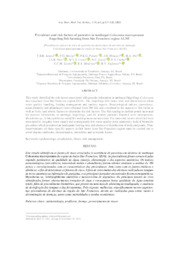Prevalence and risk factors of parasites in tambaqui Colossoma macropomum fingerling fish farming from São Francisco region AL/SE.
Prevalence and risk factors of parasites in tambaqui Colossoma macropomum fingerling fish farming from São Francisco region AL/SE.
Author(s): SANTOS, T. B. R.; MACIEL-HONDA, P. O.; PAIXÃO, P. E. G.; MENESES, J. O.; ABE, H. A.; DIAS, J. A. R.; COUTO, M. V. S.; SOUSA, N. C.; CUNHA, F. S.; SANTOS, C. C. M.; MEDEIROS, E. S.; FUJIMOTO, R. Y.
Summary: This study identified the risk factors associated with parasite infestation in tambaqui fingerlings Colossoma macropomum from São Francisco region SE/AL. The fingerlings fish farms were and characterized about water quality, handling, feeding management and sanitary aspects. Parasitological indexes (prevalence, mean intensity and abundance) were obtained from 380 fish and correlated to the aspects of fish farms as well as biotic and abiotic factors to determine the risk factors. The fish rearing in earthen ponds increased the parasite infestations in tambaqui fingerlings, and the mainly parasites founded were monogenean, Myxobolus sp., Ichthyophthirius multifiliis and digenean metacercaria. The main risk factors identified were associated to irregular water supply and consequently low water quality (total ammonia); lack of biometric procedure which promoted an inadequate feeding rate; and absence of disinfection of tools and ponds. Thus, improvements on these specific aspects in fish farms from São Francisco region must be carried out to avoid disease outbreaks, dissemination, mortalities and economic losses.
Publication year: 2022
Types of publication: Journal article
Observation
Some of Embrapa's publications are published as ePub files. To read them, use or download one of the following free software options to your computer or mobile device. Android: Google Play Books; IOS: iBooks; Windows and Linux: Calibre.
Access other publications
Access the Agricultural Research Database (BDPA) to consult Embrapa's full library collection and records.
Visit Embrapa Bookstore to purchase books and other publications sold by Embrapa.

